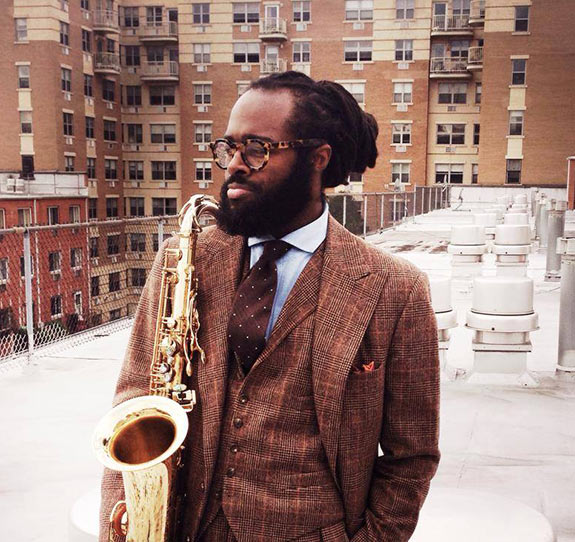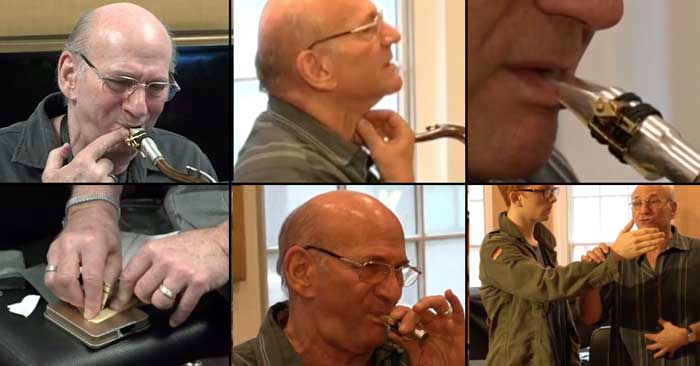Bari Sax Master Jason Marshall on What Most Players Don’t Do, and More
 Introduction
Introduction
While visiting the 2015 NAMM show, saxophonist Chad Lefkowitz Brown was nice enough to introduce me to one of my favorite baritone saxophone players, Jason Marshall. If you have not heard of Jason Marshall yet, I would recommend checking out one of his albums. I asked Jason if he would be willing to share his experience playing the saxophone specifically when it came to approaching the baritone saxophone. I have included a biography as well as my interview with Jason which I hope you will enjoy.
Biography
Jason Marshall is one of the most sought after baritone saxophonists on the scene today. Gaining wide recognition early in his career as a member of several ensembles led by trumpet star Roy Hargrove, he’s played with the likes of Aretha Franklin, Arturo O’Farrill, the Charlie Mingus Big Band Beyonce, Kenny Latimore, The Roots, Kevin Mahogany, Gladys Knight, Natalie Cole, the Isley Brothers, and the Temptations. Jason can also be found performing weekly with the iconic NYC hip hop band, Nickle & Dime Ops and with his own, The Jason Marshall Organ Trio.
An accomplished composer and arranger, he’s been nominated for a Grammy for his work on the modern day classic “Miss Garvey, Miss Garvey!!” He has also written and arranged music for the Taipei Jazz Orchestra and the New Orleans Jazz Orchestra. His work for large ensemble can be heard most regularly performed by his critically acclaimed orchestra, the Jason Marshall Big Band.
On top of all of that, he is a respected speaker and writer, giving speeches on a variety of subjects, not limited just to jazz, but also Afro-American history, classic menswear, and travel tactics. Summer 2015 will see the release of Jason’s first book “Elegance at Altitude”, the collected wisdom and best practices for the “post – 911” traveling musician.
The Interview
ZS: What made you decide to play the baritone saxophone?
JM: Well I started off playing alto saxophone. Before I entered fifth grade, I remember attending the Timerbemont music camp. I remember seeing another student named Montrell Smith, who was just a few years older and playing the baritone saxophone. I remember wanting to switch from alto to baritone saxophone and when I started 6th grade my music teacher let me play on the school baritone saxophone.
ZS: What teacher or teachers helped you progress to the saxophonist you are today?
JM: I took lessons from a variety of players. Some of those players were Holly Pasquale, Lorenz Wheatley, Paul Carr, Fred Foss, Gary Smulyan, and Ronnie Cuber. I remember Paul Carr taught me how to teach myself by listening to records and playing along with the music. Lorenz Wheatley, helped me understand how to listen to jazz and understand what the saxophone was capable of doing. Fred Foss taught me what constitutes bebop and what makes it unique. Gary Smulyan taught how to articulate on the baritone and how it was not like every other saxophone. Finally, Ronnie Cuber taught me how to make the baritone saxophone sound relevant in modern music.
ZS: How did you find it switching from alto to baritone saxophone?
JM: I was very young when I started playing baritone saxophone around age 11 or 12 and did not really notice the difference. Each teacher I worked with did not talk about airflow much and allowed me to be creative without any boundaries.
ZS: How did you develop your sound on baritone saxophone?
JM: I view my sound as relating to the human voice. I used to and still listen to such players as Grover Washington, Bruce Johnstone, Nick Brignola, Stanley Turrentine, Cannonball Adderley, and Johnny Griffin which have influenced the way I approach my sound.
ZS: What practice routine or exercise have you developed to maintain and improve your current musical ability?
JM: I work on breathing correctly and supporting my air stream. I find that most players do not use enough air when playing. Such players as Cannonball Adderley, Gene Ammons, and Dexter Gordon are great examples of players who play with enough air and support. A modern tenor player more in common with what I am trying to accomplish would be Ricky Woodard (on tenor). Some other great examples would be Abraham Burton and Greg Tardy. I also employ such saxophone practice ideas as practicing slow for the purpose of improving my ability to play fast, and to play ballads to work on my long tones. A very important idea I find that many saxophonists neglect is to pick one direction to come from. Focus on one style for a while instead of constantly jumping around.
ZS: For someone who is looking to either add the baritone to their line-up of saxophones or switch to playing baritone saxophone exclusively, what would you recommend they look for when trying out various baritone saxophones from various manufacturers?
JM: A lot has to do with the construction of the instrument. P Mauriat makes an excellent instrument through constant R&D every year. In addition, Yanagisawa, Yamaha, and Keilwerth make great baritone saxophones. I find that a well-constructed saxophone needs to be able to be taken apart and put back together many times with the pads sealing well and not any major wear over a short period of time. Although some of the vintage baritone saxophones are great saxophones, I highly recommend playing on equipment you can easily replace in the future.
ZS: Who do you find yourself listening to these days?
JM: I find myself listening to Cannonball Adderley, David Fathead Newman, Johnny Griffin, Gerald Albright, and Kirk Whalum.
ZS: What’s the next musical frontier for you?
JM: I have a travel tactics book for musicians coming out as well as one or two transcription books coming out soon. I have been writing a lot for my big band and trying to broaden my musical output. I am always trying to get better because nothing I am doing is finished. I am focused on being a leader over these next several months.
ZS: What’s your current setup?
JM:
- Soprano: P Mauriat System 76 2nd edition.
- Alto: P Mauriat Master 97.
- Tenor: P Mauriat System 76 prototype.
- Baritone: P Mauriat 300 (PMB 300) Prototype.
Mouthpiece
- Soprano: Jody Jazz DV 10.
- Alto: Jody Jazz JET 9.
- Tenor: Jody Jazz DV 10.
- Baritone: Jody Jazz DV 10.
Reed
- Soprano: Rico Orange Box 4
- Alto: Rico Select Jazz 3s
- Tenor: Rico Orange Box 4
- Baritone: Rico Orange Box 4
Ligature
- Soprano: Rovner Platinum Ligature
- Alto: Rovner Platinum Ligature
- Tenor: Rovner Platinum Ligature
- Baritone: Rovner Platinum Ligature
Other equipment:
- Mike Manning Cases
- AMT Microphones
- Hercules stands
Repair-shop
JL Woodwind Repair






December 23, 2015 @ 4:22 pm
Great interview. Informative!
December 23, 2015 @ 10:37 pm
Great interview and great interest, top marks !’????
December 27, 2015 @ 4:14 am
You said it focus on one player not skipping around. Great article
December 27, 2015 @ 1:10 pm
Good interview and smokin’ videos. Like Jason I also play Rico products. Orange box 2.5’s on tenor and LaVoz hard on alto. When I did play bari I used Rico Jazz Select 3M Unfiled. Earlier on I used Rico Royal 2.5’s on an old metal Berg Larsen 120/1 that another guy named Jimmy Lewis lent me. Jimmy was a real collector of all things musical and loved pawn shops.